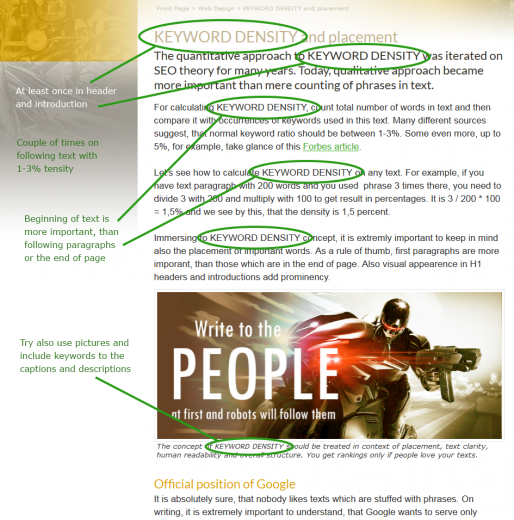websites
in BirminghamKEYWORD DENSITY and placement
The quantitative approach to KEYWORD DENSITY was iterated on SEO theory for many years. Today, qualitative approach became more important than mere counting of phrases in text.
For calculating KEYWORD DENSITY, count total number of words in text and then compare it with occurrences of keywords used in this text. Many different sources suggest, that normal keyword ratio should be between 1-3%. Some even more, up to 5%, for example, take glance of this Forbes article.
Let's see how to calculate KEYWORD DENSITY on any text. For example, if you have text paragraph with 200 words and you used phrase 3 times there, you need to divide 3 with 200 and multiply with 100 to get result in percentages. It is 3 / 200 * 100 = 1,5% and we see by this, that the density is 1,5 percent.
Immersing to KEYWORD DENSITY concept, it is extremely important to keep in mind also the placement of prominent words. As a rule of thumb, first paragraphs have more weight, than those which are in the end of page. Visual appearance in H1 headers and introductions also add prominence. |
Official position of Google It is absolutely sure, that nobody likes texts which are stuffed with phrases. On writing, it is extremely important to understand, that Google wants to serve only search results, which carry some significant meaning for human readers. If there are just comma separated phrases piled up without any glue between them, readers will not want to read nor spend much time on such pages. Natural text should also consist synonyms and have clear focus. If text is compelling, readers are more willing to read and your website quality rating goes up as a result of this.
See the video, where Matt Cutts expresses Google official stand
|
Definition of Quality Counting characters on title tag or in meta description and calculating keenly weights of particular phrases just doesn't work well any more on nowadays. Sweating to get some quantitative parameters exactly to 1,7508% is getting quite irrelevant as time goes by.
What is important then?
Well, instead of being obsessed with quantitative parameters, like keyword tensity, think more about what readers may like. There are actually only two dimensions on website what truly matter now and these will most likely stay quite same for coming decades or even longer:
Imagine readers arriving to page and not understanding what it is about. What will they do? They are most likely to hit "back" button pretty fast and go simply back where they came.
And on other end, if you are stuffing too many words in the way it reduces readability of text - readers don't like reading senseless gibberish either and will click "back" button quite snappily again.
How the hell Google knows? Well, if your text sucks, Google is surely first to know and give you as crappy rating as you deserve.
How is that possible? What kind of crystal ball is Google using?
Well, artificial intelligence is surely there, but this is not the primary source for analysing your texts. Google measures rate of "pogo sticking", which means basically the rate and time how fast users bounce back from the website after clicking link on search engine results page (shortly SERP). Pogo sticking rate is not fixed number and the algorithm is definitely not public - only Google knows about it. However, your site is compared to other similar sites with same topic and good quality means beeing just relatively better than others.
So, in other words, if your texts are not answering your readers questions nor offering compelling reading, visitors are unhappy and keep searching for something else. Google sees them jumping back and continuing to other pages and Google assigns your website quality score according to users behaviour.
Synonyms, terminology and coverage Besides of looking user action, Google looks also other phrases related to particular field - more you are expanding the topic, the more relevant phrases are there for Google to discover from your pages. Remember, that getting indexed with large array of phrases is way better than with just one single keyword.
Site overall structure helps on rankings too. If you want to rank high with keyphrase "Blue widgets", it is good if you have there also pages like
and other topics what may be relevant for your field to be considered for serious business.
If there is high competition with main phrase "Blue widget", then most likely you don't get high overall score with only cramming one phrase — without using any synonyms and expanding topics laterally at least to some extent.
Easy Guidelines for Keyword Density However, on many years of research and following hundreds of clients raise and fall on search engines, we offer you 6 step easy-to-follow recipe:
We don't only preach, but are using same guidelines also by ourselves. Please see phrases highlighted on following illustration (which is taken from the beginning of the same page you are reading right now). |
On 2021., long tail is even more important There is not much changes on using synonyms of most important phrases. What has been changed, is that Google is looking for larger variety of long tail keywords, which are specific for particular field.
Main keyword placement on header is still valid suggestion, on the end, larger variety of long tail keywords is suggested to give impression of some depth coverage of the subject. Using some natural synonyms makes text also more natural for human readability, which contributes also to various quality markers, measured by Google. |
Reach for more Writing good texts, which include proper keywords with balanced density and placement is major pillar for building good website. See also articles about more technical features as website speed, navigation usability, ergonomics of editing functionalities. Safety is extremely important too.
|
Fast Websites
Nobody likes slow website. For building fast web, you need solid and reliable website platform. Important is to host site to fast UK Web hosting server.
Web Hosting
We tested many UK Web Hosts and measured error rate and speed of web hosting servers. For reliable results, see UK web hosting firms we suggest.
Disclosure
All UK Web Hosting companies are independent firms, with own terms and conditions as well as privacy policies. Some UK Web Hosts stipend us.
Ask a Quote
Ara Website Design Ltd., 11477099,
Fastest Websites in Birmingham
For Website Design, Ask a Quote or
send us e-mail.




